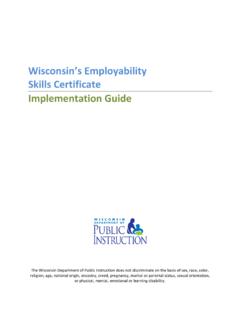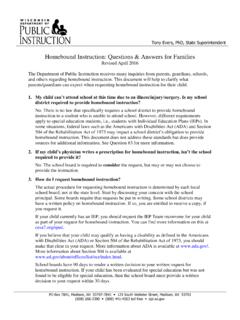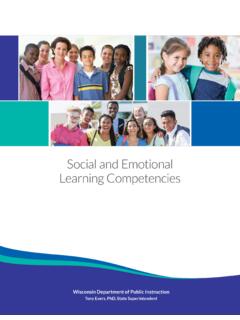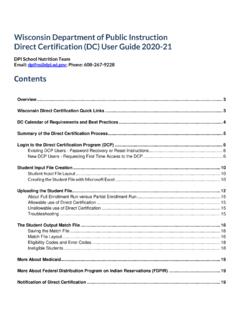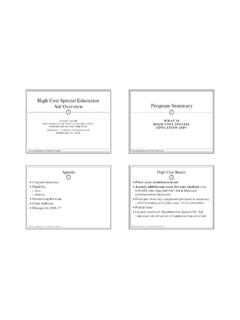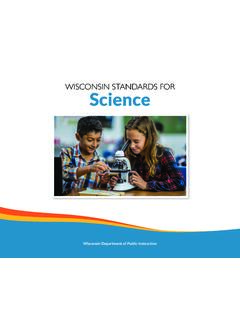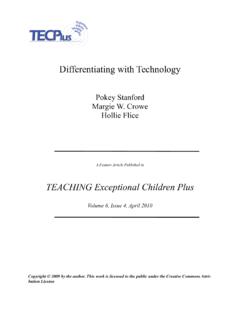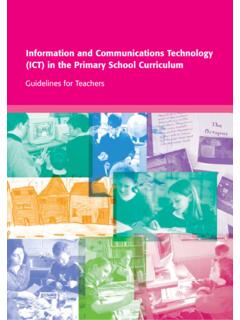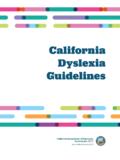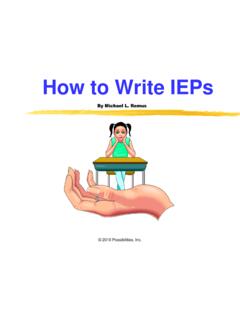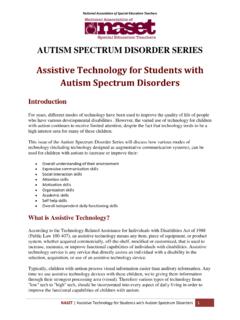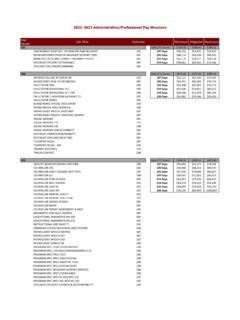Transcription of SUPPORTING STUDENTS WHO ARE DEAF/H OF HEARING IN …
1 SUPPORTING STUDENTS WHO ARE DEAF/HARD OF HEARING IN WI PUBLIC SCHOOLS Information for public school administrators and pupil services personnel about educating STUDENTS with HEARING loss HEARING loss can significantly impact the full spectrum of a child's development, and can have a domino effect on: Language and literacy development Academic achievement Social/emotional development American Speech/Language HEARING Association THE DOMINO EFFECT ACOUSTICAL SOCIETY OF AMERICA IMPACT ON LANGUAGE DEVELOPMENT HEARING loss impacts the development of receptive and expressive communication skills which can lead to reduced background knowledge and incidental learning* Communication difficulties often lead to social isolation and poor self-concept and may have an impact on vocational choices.
2 WI DPI Eligibility Criteria Guidelines Pragmatic language use (interjections, apologies, ability to compare/contrast, problem solving, repairing conversation breakdown) is slower to develop in deaf/ hard of HEARING children Yoshinaga-Itano 2012 IMPACT ON INCIDENTAL LEARNING The literature in developmental psychology reveals that about 90% of what very young children know about the world is from incidental learning. (Moog & Geers, 2003) For the child unable to overhear the full and natural exchange of language in the home, community and at school, gaps in language development and world knowledge may occur. The more significant the HEARING loss, the greater potential for a gap which may not be immediately evident.
3 Therefore, children with HEARING loss need to be taught directly many of the skills that other children learn incidentally. ( Mainstreaming the Student who is Deaf or Hard of HEARING , Hands & Voices, ) IMPACT ON ACADEMIC ACHIEVEMENT Children with HEARING loss often need explicit instruction from a specialized provider to acquire the same information another child learns incidentally. Children with HEARING loss may have difficulty in all areas of academic achievement, especially reading and language based mathematical concepts. American Speech, Language and HEARING Association IMPACT ON SOCIAL DEVELOPMENT, SELF-ESTEEM AND IDENTITY STUDENTS may perceive themselves as different. Reduced ability to communicate may interfere with development of age appropriate social skills and interaction with peers.
4 HEARING loss may look like the child is less attentive, fatigued, easily frustrated and less confident in the classroom. Cognition in the Classroom: The Academic and Social Implications An Interview with Dr. Brenda Schick. HEARING loss may impact up to 15% of school-aged STUDENTS it is not a "low incidence disability. (Center for Disease Control) HEARING loss affects 12,000 children born in the United States each year, making it the most common birth defect. (White, 1997) DR. ROBERT DAVILA, OFFICE OF SPECIAL EDUCATION PROGRAMS STUDENTS who are deaf or hard of HEARING do not need to fail in order to receive services but need to show adverse effects or indicators of linguistic and academic delay. For the youngest children, there may be indicators that demonstrate that the child is likely to develop a delay.
5 Inability to directly communicate with peers has a negative impact on academic success, social development and self esteem. The needs of STUDENTS with mild to moderate HEARING loss and those with a unilateral HEARING loss may also be educationally significant due to the complex and invisible nature of the disability. THERE ARE VARYING DEGREES OF HEARING IMPAIRMENT The degree of loss does not directly equate to the amount of educational impact STUDENTS with unilateral HEARING loss are more impacted by noisy listening situations than their normal HEARING peers Anne Marie Tharpe Audiology Online 2007 The degree of HEARING loss does not directly equate to a student s intellectual or academic abilities. EARLY INTERVENTION Age of enrollment into early intervention and family involvement are the two key factors in language development success of HEARING impaired STUDENTS Dr.
6 Mary Pat Moeller, Pediatrics, 2000 Most children with HEARING loss who receive appropriate services from *trained staff are able to progress at age-appropriate rates. (Geers et al., 2009) *Wisconsin requires teachers to be highly qualified HEARING LOSS WITH OTHER DISABILITIES u As many as 50% of STUDENTS with HEARING loss have other disabilities. Perigo, Volta Review u STUDENTS with HEARING loss as their identified disability may need the support of other special education professionals in order to be successful. u STUDENTS with HEARING loss and other disabilities also need the support of personnel trained to work with children who are deaf or hard of HEARING . CHILDREN WITH HEARING LOSS MAY NEED EDUCATIONAL SUPPORT Teachers of the deaf/hard of HEARING Educational Audiologists Speech/Language Pathologists Interpreters Resource/Special Educators School Nurse Counselors Guidance Transition coordinators EXPANDED CORE CURRICULUM Some functional skill development may be required of STUDENTS who are deaf or hard of HEARING in order to access the General Education curriculum and achieve the Wisconsin Model Academic Standards, which include the Common Core State Standards ).
7 These skills are outlined in the Wisconsin Expanded Core Curriculum ( ) and may include instruction in: Expansion of language and vocabulary development Communication strategies Social skills Life skills, including vocational and experiential opportunities Self-advocacy Effective use of an interpreter Speech perception and production Use of assistive technology Having an equal opportunity to learn requires that children with HEARING loss have access to information that most children have through listening Conference on Educational Administrators of Programs and Schools for the Deaf PROVIDING ACCESS assistive technology ( HEARING aids, FM system, cochlear implants) is not a substitute for normal HEARING . Even the best listening technology cannot fix the HEARING loss. technology needs can change during school years Even with technology , the ability to listen with comprehension can be significantly impacted in noise, at a distance, and/or when more than one person is speaking.
8 Visual supports, such as sign language interpreters, or captioning may be needed to provide access. Providing supports does not create dependence; rather these supports can promote independence in learning by giving access to the learning environment. POTENTIAL VISUAL SUPPORTS Captioning Notes provided Visual cues Props Graphic organizers Media presentations Educational Interpreters Adequate lighting CONSIDER OTHER BARRIERS TO Inability to overhear and obtain information through incidental learning Extra effort and attention needed to listen with both eyes and listening technology can be exhausting. Difficulty in speechreading (lipreading) teachers and peers at times when their faces are not easily visible. High level of noise in classrooms and other school environments (lunch room, gym, etc) Visual noise that occurs when the lighting is not adequate or there are too many visual distracters in the room.
9 Behavioral and/or socialization issues may arise due to lack of understanding and fatigue. It is important to consider the effort necessary for the student to access the environment, in addition to their individual auditory and visual needs. The consistency and intensity of support provided children with HEARING loss is directly related to their success in the school setting - best achieved with professional team and parents. IDEA 2004, National Association of State Directors of Special Education "Deaf and Hard of HEARING STUDENTS Educational Service Guidelines FREE APPROPRIATE PUBLIC EDUCATION ( 34 CFR TO 113) A free appropriate public education ( FAPE) is purposely designed to move each child toward meaningful outcomes. An education that is appropriate for a child with HEARING loss needs to address the unique communication, academic, and linguistic needs of that child.
10 If these unique needs are addressed, children with HEARING loss can achieve meaningful outcomes commensurate to their HEARING peers. LEAST RESTRICTIVE ENVIRONMENT To the maximum extent appropriate, children with disabilities .. are educated with children who are nondisabled, in the least restrictive environment (LRE). When considering LRE, note: Access to nondisabled peers and to the general curriculum are not achieved by simply placing the student in a regular education classroom. STUDENTS with HEARING loss need communication access, and may need other classroom and curricular modifications in order access the general education curriculum and ensure that the environment is not restrictive for the child s learning and interactions. CONTINUUM OF PLACEMENT OPTIONS One size does not fit all. Educational placement is to be determined based on the child s individual needs.


